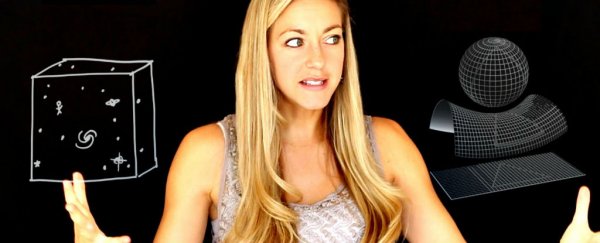
It's completely nuts that in 2016, we're still arguing about the possibility of Earth being flat. So ridiculous that ancient Greek philosophers could hop in a time machine, travel 2,000 years into the future, get out, laugh at how uninformed and ignorant we are, then hop back in and return to a time when eating beans was suspect because they were thought to contain the souls of the dead.
The thing is, of you need something crazy to believe in that's actually scientific fact, all you need to do is look beyond our tiny planet and into the Universe, which, believe it or not, is actually flat. So our very round Earth is sitting in a very flat Universe. How is that even possible?
As Physics Girl explains in the video above, the Universe is flat, which means it's just the right mass density that it will neither expand forever like a cylinder nor collapse back on itself like a sphere (she's got some great diagrams to help you wrap your head around how this actually works).
Perhaps even more strange is the fact that completely opposite ends of the Universe, that haven't even had time to interact, are somehow the same temperature. Why is that weird? Well, think about when you pour some milk into a cup of hot tea - it takes a bit of time for the milk to swirl around and fill the cup evenly and distribute a uniform temperature in the newly mixed liquids.
The Universe is kind of the same - the fastest that two things can interact with each other is as soon as light has had time to travel between them, and as Diana explains, conventional Big Bang theory says there hasn't been time for light to travel from one side of the Universe to the other in the 13.8ish billion years it's been around.
Exactly how the Universe could be flat, and with an entirely uniform temperature, were two of the biggest unanswered questions in cosmology, until about 30 years ago, when physicist Alan Guth and his colleagues came up with the theory of cosmic inflation.
Basically, in order for everything in the Universe to have the same temperature, the Universe would have to expand a whole lot since its formation. And when I say a whole lot, I really mean it - as the video above explains, 13.7 billion years years ago, everything in the observable Universe fit in the volume of a billionth the size of a proton. And it expanded from this, as Diana explains, "unfathomably fast".
How? Well, it's thanks to that old cosmic mainstay - gravity. The one thing that rules us all. I'll let Guth himself explain that one for you in the video above, but let's just say learning how the Universe became flat and enormous is a whole lot more interesting than debating baseless conspiracy theories.
